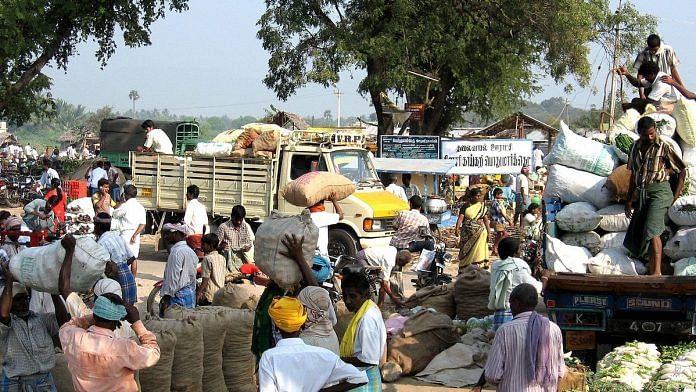New Delhi: High inflation has troubled policymakers from the beginning of this year, with the Reserve Bank of India (RBI) hiking the repo rate (lending rate to banks) thrice by 140 basis points in the last four months to contain it. More rate hikes are likely as inflation remains above the RBI’s upper tolerance limit of six per cent.
A deeper look into the inflation numbers this year reveals another trend — higher inflation in rural areas than in the urban areas.

Going by the Ministry of Statistics and Programme Implementation’s releases, inflation rates in rural India were higher than in urban areas for the first seven months this year. In contrast, the inflation rate in the hinterland was higher than in urban parts for six months in 2021, whereas it remained more subdued than in urban areas throughout 2020.
In July, when the monthly data was published last, the inflation rate in rural and urban regions were 6.8 per cent and 6.49 per cent, respectively.
Also Read: India must gear up to face US recession. Inflation control comes at cost of growth
Why this trend?
One of the major reasons rural India is facing a higher rate of inflation lies in the way the figure is calculated for the two regions.
The Consumer Price Index (CPI) — an indicator of inflation — in essence measures the movement in prices of a bundle of goods, which are assigned weights based on their importance. The goods are further classified into broader categories — food and beverage, clothing and footwear, housing, fuel and light, ‘pan, tobacco and toxicants’ and miscellaneous.
The key difference between rural and urban inflation rate calculations lies in the weightage attached to certain groups of commodities. In rural areas, the food and beverage sector alone makes up about 54.18 per cent of the CPI basket. The same sector carries a weight of 36.29 per cent for urban areas, thereby accounting for a little more than a third of the consumption basket.
The reason for this lower weightage is that price trends in housing are incorporated in the CPI index for urban areas, but not for rural areas. This means that rural consumers are more susceptible to food inflation than their urban counterparts — and that’s exactly what has happened.
In July, the year-on-year increase in the Consumer Food Price Index (CFPI) — which essentially measures changes in food prices — was 6.80 per cent for rural and 6.69 per cent for urban India, a difference of 11 basis points.
The gap was bigger in March when the inflation rate was the highest since October 2020, as India, like the rest of the world, was feeling the ripples of the Russia-Ukraine war. With rural and urban CFPI at 8.04 and 7.04 per cent respectively, the gap was 100 basis points. Back then, the price of edible oil in the countryside was up by 20.75 per cent, while it rose by 15.15 per cent in urban areas.
Is it unusual?
A cursory look at the inflation data shows that at least for the past three-four years, the rural inflation rate has remained broadly lower than that for urban regions. But this wasn’t always the case. Higher inflation rates in rural areas were the norm before 2018, according to an article, ‘Rural-Urban Inflation Dynamics in India’, published by the RBI in its December 2020 bulletin.
According to the article written by Binod B. Bhoi, Himani Shekhar and Ipsita Padhi, the growth in average annual inflation rates in rural India was generally higher than that of urban India from the financial year 2012-13 till 2017-18.
It was from the financial year 2018-19 onwards the urban India’s inflation rate started rising faster, and it’s possible that the 2022 numbers reflect a return to the earlier status quo. The crux of the RBI analysis was that in terms of following patterns or trends, rural and urban India’s inflation rates don’t diverge significantly.
Also Read: Global slowdown could hurt India but don’t worry too much about recession in 2023
Inflation still a concern
The numbers may give an impression that rural inflation outpacing urban levels may not be unusual, since India has already faced this trajectory prior to 2017-18. Only in recent years have the tables turned. Nonetheless, experts believe it’s still a matter of concern.
With prices remaining above the tolerable range of 4-6 per cent for the past six consecutive months, a higher rural inflation rate isn’t a good signal when there is uncertainty about food production, said experts.
Dipti Deshpande, principal economist at credit rating agency CRISIL, told ThePrint: “Rural wages are unable to keep pace with rising inflation. In 2022 (the January-June period), agricultural and rural wages have on average grown 4.2 per cent and 4.3 per cent year-on-year respectively in nominal terms, compared to 7.1 per cent average CPI inflation. With wage growth being negative in real terms (that is, nominal wage growth minus consumer price inflation), purchasing power is weaker this year, which could hit revival in consumption demand this fiscal.”
With the heat wave in the summer affecting its wheat production estimates, India may have to import it during the winters. The erratic and uneven rains have also “muted” consumer sentiment, especially in rural India, independent think tank CMIE’s CEO and managing director Mahesh Vyas had written in Business Standard.
(Edited by Tony Rai)
Also Read: Cost of a veg Indian thali has jumped 42% since 2015. That too without curd, tea, fruits



